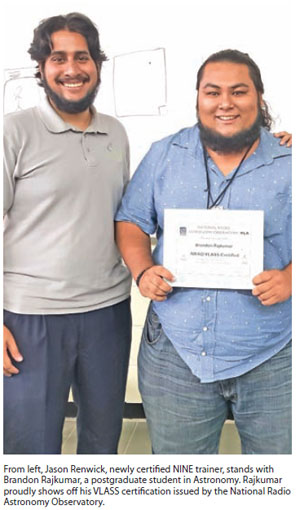 |
 |
 |
|
October 2018
|
Quite a lot, actually. As science writer Sarah Scoles has observed (Learn to Code or Get Left Behind, Wired magazine, May 26, 2017) , today’s astronomers don't just need to know how stars form and black holes burst: “They also need knowledge of how to pry that information from the many terabytes of data that will stream from next-generation telescopes... So they're largely teaching themselves—using a suite of open-source training tools, focused workshops, and fellowship programmes to help and actually prepare astronomers for the universe they’re entering.” Enter Python. The Python programming language is a tool for basic research and engineering, and is becoming one of the most widely used languages for data analysis. In the field of astronomy, Python is increasingly used both by institutions developing software for new instruments, telescopes and missions, and by astronomers for use in analyzing their massive amounts of data. The MeerKat telescope array in south Africa, for instance, generates many terabytes of data in just a single minute (https://www.nature.com/articles/d41586-018-01838-0). Here at The UWI, Jason Renwick (a 2018 UWI graduate in Electrical and Computer Engineering) held a workshop last month (September 15) at the Faculty of Science and Technology on “How to display radio astronomy images with Python.” Jason, in addition to being a former 2014 NASA International Internship Program intern, recently returned from another training opportunity: the Summer 2018 NINE programme, which he attended from June 2 – July 31, 2018 at Green Bank, West Virginia. There, Jason developed a web app, created on Rasberry Pi (a low-cost, credit card-sized Linux computer), to organize, curate, and process images provided from data captured by astronomy telescopes. “The main goal is to find radio images in the dataset, for instance, images suggesting galaxies. I have found about 200 (previously discovered) galaxies from datasets I’ve examined. The Python programming language helps process all this data,” said Jason in an interview with UWI Today. Coming out of this experience, Jason is now a NINE-certified trainer. NINE stands for the National and International Non-Traditional Exchange (NINE) Program with the National Radio Astronomy Observatory (NRAO). The NRAO is based in five sites in the USA, including Green Bank, West Virginia, where Jason went. The NRAO is a US Federally Funded Research and Development Center of the United States National Science Foundation for the purpose of radio astronomy. The NRAO designs, builds, and operates its own high sensitivity radio telescopes for use by scientists around the world. Jason explained that our Caribbean location may be considered a dead zone for radio astronomy because it is often difficult to collect astronomical data from telescopes in conditions of high humidity. However, because of the huge amount of data captured by radio telescopes elsewhere, the process of helping to crunch some of this data is an interesting opportunity for many countries and budding astronomers. The Open Skies Policy applied to astronomy helps ensure that researchers in less-advanced countries—which cannot fund major telescopes or be part of international collaborations—have access to the instruments they need to carry out their research, and have access to specific project data too. Jason’s UWI Engineering degree helped prepare him for his NINE training opportunity by giving him a good foundation in electronics and related software. He said: “My undergrad studies in electrical and computer engineering at UWI were much more of an asset to have going into the NINE programme than I could have predicted. Radio astronomy has a notable reliance on electronics to enable the collection/observation of radio waves. Being familiar with electronics and the related software made my introduction to radio astronomy very smooth. “The NINE programme contained a significant emphasis on project management and data science. Following the nine-week training programme, I had a greater appreciation for how project management facilitates successful projects. In particular, when applying project management techniques to endeavours such as the UWI NINE Hub, it allows for greater mitigation of risks, increases accountability and ultimately, enhances the level of achievement. “On completion of the programme, I had greater respect for the science behind radio astronomy. Only a small portion of the electromagnetic spectrum is made up of visible light. Hence, radio astronomy gives a unique perspective on galactic entities, known and unknown. Sometimes, it answers previously unanswerable questions.” |


 What does computer code have to do with the stars?
What does computer code have to do with the stars?